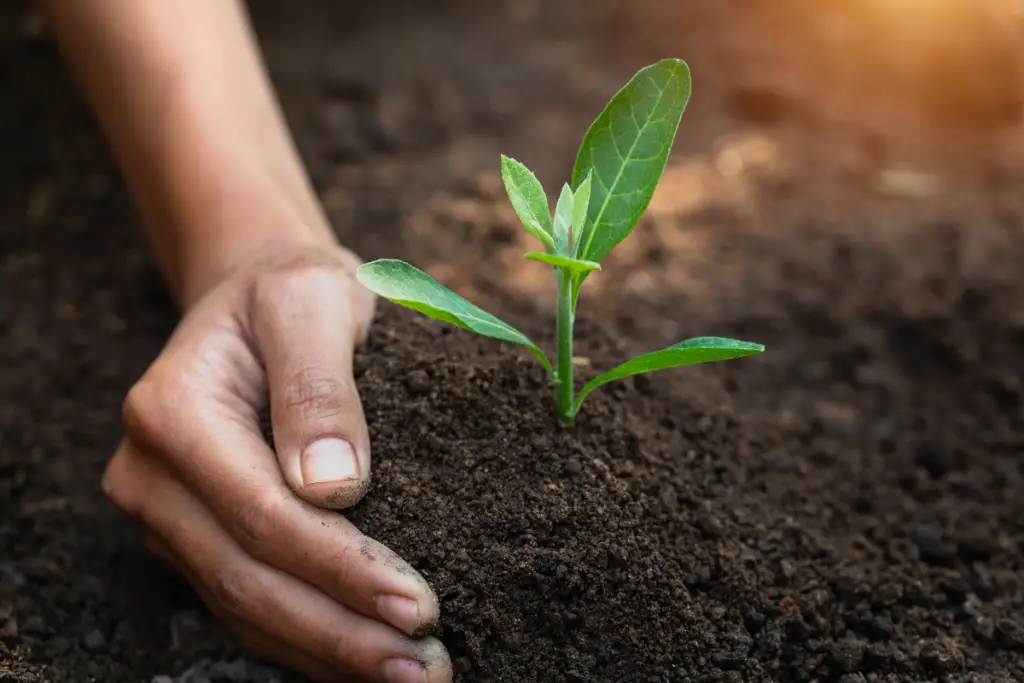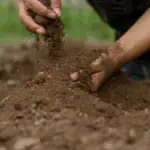When it comes to growing plants, soil is one of the most important factors to consider.
The right type of soil can make all the difference in the health and growth of your plants.
But with so many different types of soil available, it can be difficult to know which one is best for your needs.
The first thing to consider when choosing soil is the type of plant you will be growing.
Different plants have different soil requirements, so it’s important to choose a soil that will provide the right nutrients and drainage for your specific plant.
For example, succulents and citrus trees need fast-draining soil, while vegetables and herbs thrive in nutrient-rich soil with good water retention.
Another important factor to consider is the type of soil in your area. Soil can vary greatly depending on location, with factors like climate, geology, and topography all playing a role.
Understanding the type of soil in your area can help you choose the right soil amendments to improve your soil quality and provide the best-growing conditions for your plants.

Table of Contents
Understanding Soil Types
When it comes to gardening, understanding the different types of soil is crucial for the success of your plants.
There are six main types of soil: sandy, clay, silt, peat, chalk, and loam.
Each of these soil types has unique properties that affect plant growth.
Sandy Soil
Sandy soil is composed of large particles that do not hold water well, making it difficult for plants to absorb nutrients.
However, sandy soil is easy to work with and warms up quickly in the spring, making it ideal for early planting of heat-loving crops like tomatoes and peppers.
Clay Soil
Clay soil is composed of very fine particles that hold water well, but can become waterlogged and compacted, making it difficult for roots to grow and for air to circulate.
Clay soil is rich in nutrients, making it ideal for growing crops like kale, broccoli, and cabbage.
Silt Soil
Silt soil is composed of medium-sized particles that hold water and nutrients well, making it ideal for growing crops like corn, beans, and peas.
However, silt soil can become compacted over time, making it difficult for roots to penetrate.
Peat Soil
Peat soil is composed of partially decomposed organic matter and is high in nutrients.
However, peat soil is acidic and can be difficult to work with, making it less ideal for growing crops.
Chalk Soil
Chalk soil is composed of calcium carbonate and is alkaline in nature.
Chalk soil is well-draining and warms up quickly in the spring, making it ideal for growing crops like grapes, tomatoes, and peppers.
However, chalk soil can be low in nutrients and may require additional fertilization.
Loam Soil
Loam soil is a mixture of sand, silt, and clay and is considered the ideal soil type for gardening.
Loam soil is well-draining, holds water and nutrients well, and is easy to work with.
Most plants thrive in loam soil, making it the go-to soil type for most gardeners.
Understanding the different types of soil and their properties can help you choose the best soil type for your plants.
By selecting the right soil type, you can ensure that your plants have the best chance of success.
Importance of Soil pH for Plant Growth
Soil pH is a crucial factor that affects plant growth and development. It determines the availability of essential nutrients in the soil, which are required for plant growth.
The pH scale ranges from 0 to 14, with 7 being neutral. A pH below 7 is acidic, while a pH above 7 is alkaline.
Most plants prefer a slightly acidic to neutral soil pH, ranging from 6.0 to 7.0.
If the soil pH is too low or too high, it can lead to nutrient deficiencies or toxicities, which can affect plant growth and yield.
For example, acidic soils with a pH below 5.5 can cause aluminum toxicity in plants, which can stunt growth and reduce yields.
On the other hand, alkaline soils with a pH above 8.5 can cause iron and manganese deficiencies, which can also affect plant growth.
Different plants have different soil pH requirements.
For instance, blueberries, azaleas, and rhododendrons prefer an acidic soil pH between 4.5 and 5.5, while asparagus and ferns prefer a neutral to slightly alkaline soil pH.
Therefore, it is essential to know the soil pH requirements of the plants you want to grow and adjust the soil pH accordingly.
Soil pH can be adjusted by adding lime to raise the pH or sulfur to lower the pH.
However, it is important to note that these amendments take time to work and should be applied well in advance of planting.
It is also important to test the soil pH regularly to ensure that it remains within the desired range for optimal plant growth.
Role of Organic Matter in Soil
Organic matter is an essential component of soil that plays a crucial role in plant growth and development.
It is the decomposed remains of plants, animals, and microorganisms that enrich the soil with nutrients, water-holding capacity, and other benefits.
When organic matter decomposes, it releases essential nutrients such as nitrogen, phosphorus, and potassium, which are vital for plant growth.
Additionally, it enhances the soil’s water-holding capacity, which helps plants to survive during dry periods.
Organic matter also improves soil structure by binding soil particles together, which creates pore spaces that allow air and water to move through the soil.
Cover crops, reduced tillage, and rotational or prescribed grazing are some of the practices that can increase organic matter in soil.
Higher residue rotations and cover crops contribute more organic matter and nutrients to the soil, while less soil disturbance means lower organic matter losses.
It is important to note that not all organic matter is created equal.
The quality of organic matter depends on its source, composition, and how it decomposes. For example, fresh manure can contain high levels of nitrogen, but it can also contain weed seeds and pathogens that can harm plants.
In contrast, well-composted organic matter is rich in nutrients and beneficial microorganisms that can improve soil health.
Nutrient Requirements of Plants
Plants require a variety of nutrients to grow and thrive, with the three most important being nitrogen, phosphorus, and potassium.
Each of these nutrients plays a different role in the growth and development of plants.
Nitrogen
Nitrogen is a vital component of plant growth, as it is a major building block for amino acids and proteins.
Plants require a steady supply of nitrogen throughout their growth cycle, and a lack of nitrogen can result in stunted growth, yellowing leaves, and poor yields.
Some plants are better adapted to low-nitrogen soils than others, but most plants benefit from regular applications of nitrogen-rich fertilizers.
Common sources of nitrogen include animal manure, compost, and synthetic fertilizers.
Phosphorus
Phosphorus is another essential nutrient for plant growth, playing a key role in photosynthesis, energy transfer, and cell division.
Like nitrogen, a lack of phosphorus can result in stunted growth and poor yields.
Phosphorus is less mobile in soils than nitrogen, meaning that it is less likely to leach away into groundwater.
However, it is also less available to plants, as it tends to bind tightly to soil particles. For this reason, it is important to ensure that soils are rich in phosphorus before planting.
Potassium
Potassium is the third major nutrient required by plants, playing a key role in water uptake, photosynthesis, and the regulation of stomatal openings.
It also helps plants to resist stress and disease.
Potassium is more mobile in soils than either nitrogen or phosphorus, meaning that it is more likely to leach away into groundwater.
However, it is also more available to plants, as it is not strongly bound to soil particles.
Potassium-rich fertilizers can help to ensure that plants have an adequate supply of this vital nutrient.
Water Retention in Different Soil Types
Water retention is an important factor to consider when choosing soil for growing plants.
The ability of soil to retain water affects the availability of moisture to plants, which is crucial for their growth and survival.
Different soil types have different water retention capacities, which can impact plant health and productivity.
Sandy Soil
Sandy soil has large particles that do not pack together tightly, allowing water to drain quickly.
This means that sandy soil has low water retention capacity, making it difficult for plants to access moisture.
However, sandy soil is well-aerated and easy to work with, making it suitable for certain types of plants that prefer well-drained soil.
Clay Soil
Clay soil has small particles that pack together tightly, which can make it difficult for water to penetrate.
However, once water is absorbed, clay soil has high water retention capacity, which can be beneficial for plants during dry periods.
Clay soil can be heavy and difficult to work with, but it is suitable for plants that require moist soil.
Loamy Soil
Loamy soil is a mixture of sand, silt, and clay, which gives it a balance of drainage and water retention.
Loamy soil has good water retention capacity, while also allowing excess water to drain away.
This makes it suitable for a wide range of plants that require well-draining soil with adequate moisture.
Improving Water Retention
Regardless of soil type, there are ways to improve water retention.
Adding organic matter, such as compost or aged manure, can increase the water holding capacity of soil.
Inorganic amendments, such as vermiculite or perlite, can also improve water retention, but may be more expensive.
Understanding the water retention properties of different soil types can help gardeners choose the best soil for their plants and take steps to improve water retention as needed.
Soil Preparation for Plant Growth
Soil preparation is a crucial step in ensuring healthy plant growth. The right soil can provide plants with the nutrients they need to grow strong and healthy.
Here are some tips for preparing the soil for optimal plant growth:
Add Organic Matter
Adding organic matter to the soil can improve its structure and nutrient content. Compost and aged manure are excellent sources of organic matter.
They not only feed the soil with nutrients but also drain well, loosen the soil to create more oxygen for plants, and stabilize and anchor plant roots.
Spread a minimum of 2 to 3 inches of compost or aged manure onto your soil (and no more than four inches).
Till and Dig as Little as Possible
Tilling and digging can disrupt the soil structure and damage beneficial microorganisms.
Instead, add organic matter to the top inch or two of soil, or just lay it right on top of your garden and let the earthworms work it in for you.
This will help improve soil structure and promote healthy plant growth.
Test Soil pH
The pH level of soil can affect plant growth. Most plants prefer a slightly acidic soil with a pH between 6.0 and 7.0.
Test your soil pH with a soil test kit, available at most garden centers. If the pH is too low, add lime to raise it. If the pH is too high, add sulfur to lower it.
Consider Soil Texture
Soil texture refers to the size of the soil particles. Sandy soils drain quickly but may not hold enough nutrients.
Clay soils hold water well but can be slow to drain and may become compacted. Loamy soils are a good balance of sand, silt, and clay and are ideal for most plants.
Consider your soil texture when choosing plants and adding amendments.
By following these tips for soil preparation, you can help ensure healthy plant growth and a bountiful harvest.
Best Soil Types for Specific Plants
Different plants have different soil requirements for optimal growth.
Here are the best soil types for specific plants:
Vegetables
Vegetables grow best in a rich, well-draining soil that is high in organic matter.
A loamy soil that is a mix of sand, silt, and clay is ideal for most vegetables. However, some vegetables have specific soil requirements:
- Tomatoes: Tomatoes prefer a slightly acidic soil with a pH between 6.0 and 6.8. They also need a lot of nutrients, so adding compost or aged manure to the soil can help.
- Carrots: Carrots need loose, sandy soil that is free of rocks and other debris. Heavy soil can cause the roots to become misshapen.
- Potatoes: Potatoes grow best in a well-draining, slightly acidic soil with a pH between 5.0 and 6.0. They also need a lot of nutrients, so adding compost or aged manure to the soil can help.
Flowers
Flowers have different soil requirements depending on their type. Here are some examples:
- Roses: Roses prefer a slightly acidic soil with a pH between 6.0 and 6.5. They also need a lot of nutrients, so adding compost or aged manure to the soil can help.
- Marigolds: Marigolds grow well in any well-draining soil, but they prefer a slightly alkaline soil with a pH between 6.0 and 7.0.
- Petunias: Petunias prefer a well-draining soil that is slightly acidic with a pH between 5.5 and 6.5.
Fruits
Fruit trees and bushes have specific soil requirements for optimal growth. Here are some examples:
- Blueberries: Blueberries grow best in an acidic soil with a pH between 4.5 and 5.5. They also need a lot of organic matter, so adding peat moss or aged manure to the soil can help.
- Apples: Apples prefer a slightly acidic soil with a pH between 6.0 and 6.5. They also need a lot of nutrients, so adding compost or aged manure to the soil can help.
- Citrus: Citrus trees need a well-draining soil that is slightly acidic with a pH between 6.0 and 7.0. They also need a lot of nutrients, so adding citrus-specific fertilizer to the soil can help.
Trees and Shrubs
Trees and shrubs have different soil requirements depending on their type. Here are some examples:
- Oak trees: Oak trees prefer a well-draining soil that is slightly acidic with a pH between 6.0 and 6.5.
- Azaleas: Azaleas prefer a well-draining soil that is slightly acidic with a pH between 4.5 and 6.0. They also need a lot of organic matter, so adding peat moss or aged manure to the soil can help.
- Japanese maples: Japanese maples prefer a well-draining soil that is slightly acidic with a pH between 5.5 and 6.5. They also need a lot of organic matter, so adding compost or aged manure to the soil can help.
Conclusion
In conclusion, choosing the right soil for your plants is crucial to ensure their healthy growth and development.
The ideal soil should be well-drained, rich in nutrients, and have a balanced pH level.
It is important to note that different plants have different soil requirements, so it is vital to research the specific needs of your plants before selecting a soil.
Additionally, adding organic matter to your soil can greatly improve its quality and fertility.
By taking the time to select the best soil for your plants, you can help them thrive and achieve their full potential.
- How to Dry Basil Leaves: A Professional Guide
- Is an Avocado a Fruit or Vegetable? Simple Answer and Explanation
- Does Pineapple Have Seeds? Exploring the Anatomy of Pineapples
- Blooming Through Winter: Can I Grow Vegetables Indoors in the Winter?
- What Can You Grow in a Greenhouse All Year Round: A Guide to Year-Round Greenhouse Gardening
- Are Blueberries Blue? Debunking the Myth of Their Color
















